When most people think of Colorado, they picture snowcapped peaks and mountainsides lined with evergreen trees. Though they can look similar from afar, there are a myriad of native evergreen species that are found throughout the Rocky Mountains.
Evergreen plants grow as both trees and shrubs, though most are trees. They are called evergreens because they keep their green leaves all year round. All classified as conifers, Latin scientific name Pinophyta, the evergreens in Colorado come in four main types:
- Pines
- Spruces
- Firs
- Junipers
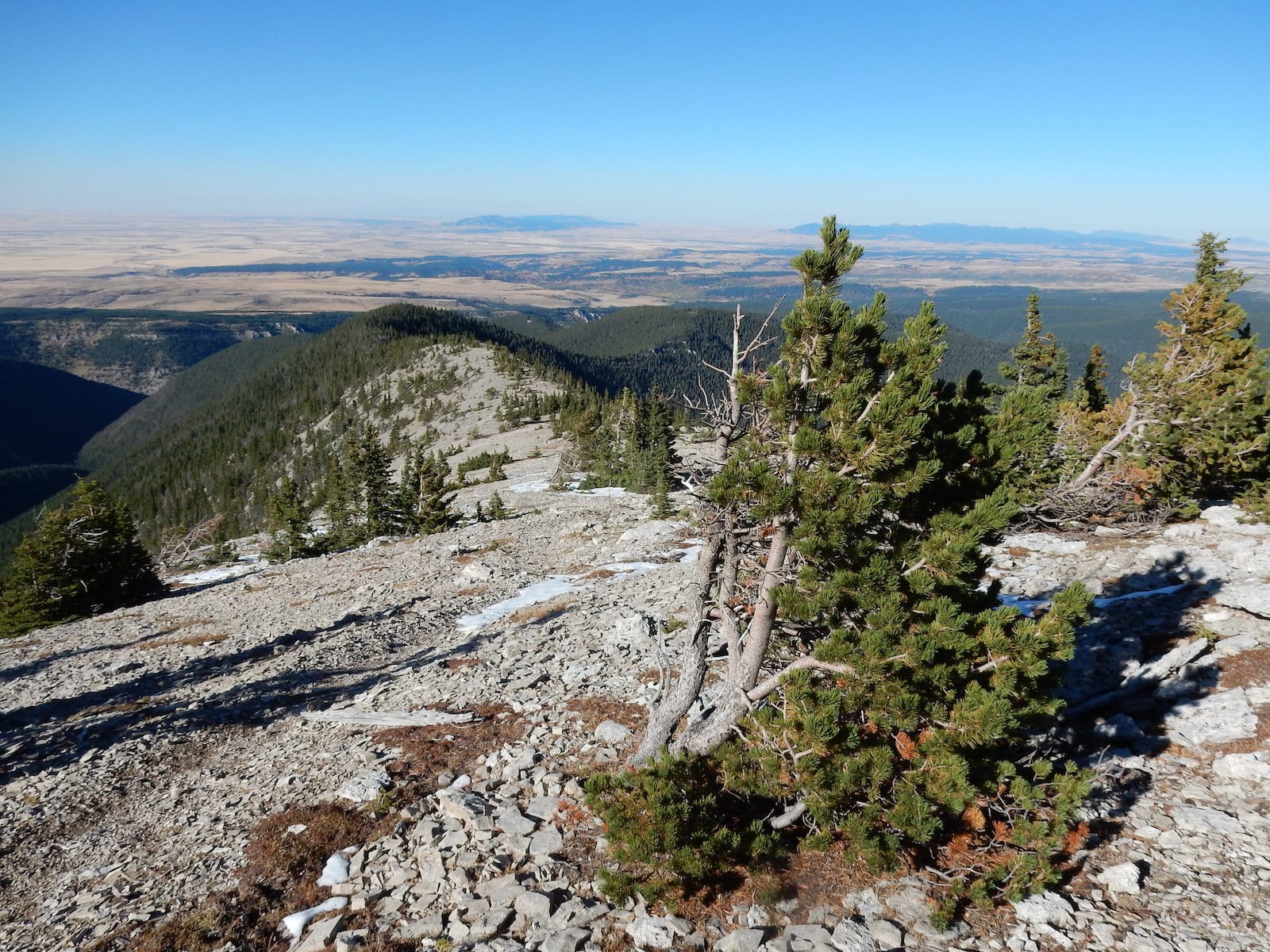
Around the world, outside of Colorado, you’ll find other types of conifers, such as cedars and hemlocks. Conifers are gymnosperms, cone-bearing seed plants. Interestingly, many varieties alter their biochemistry in the colder seasons to help them against freezing.
Many of the evergreen species in Colorado can endure very cold temperatures, some colder than others. Also, some are more adapted to living in dryer climates with little rainfall than others. Whether you’re looking to plant a few conifer trees or shrubs in your yard or just identify the tall trees you pass on your hike, we’ve compiled a list of the most common evergreens native to Colorado.
Here are the native evergreen trees found in Colorado, in alphabetical order:
Blue Spruce
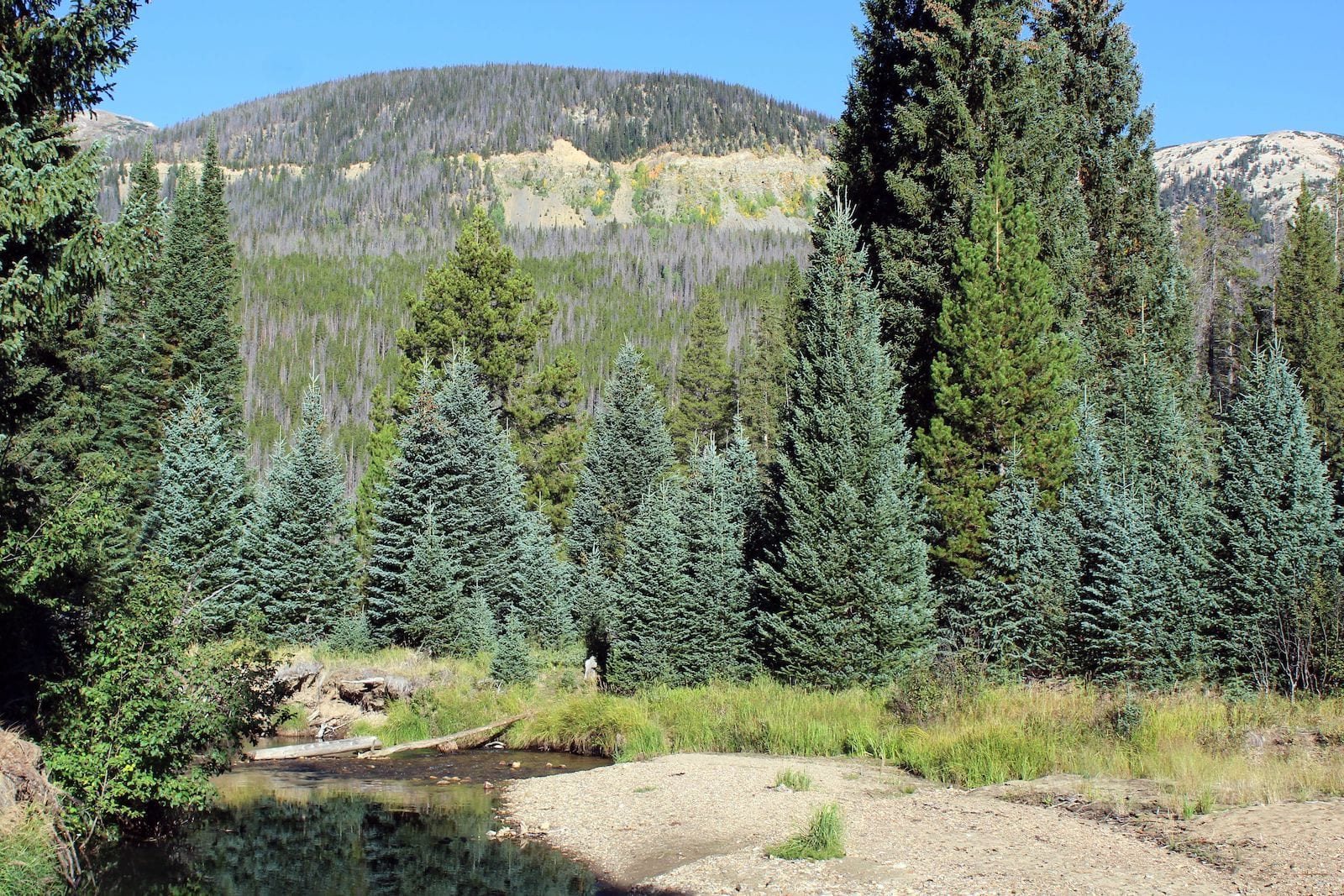
- Latin Scientific Name – Picea pungens
- Nicknames – Blue spruce, green spruce, white spruce, Colorado spruce, Colorado blue spruce
- Mature Size – Average Height of 75-135′
The blue spruce is well known for its silvery, blueish hue. It’s native to North America and found throughout zones 1 to 7, in places from New Mexico, Colorado, Utah, and Wyoming, up into Alberta and British Columbia, Canada. It handles high wind well, in part thanks to its deep root system, making it a great wind break. It’s also a long-lived species, which grows in a columnar, pyramidal shape. It grows 3-4″ brown cones, which concentrate in the upper crown.
It makes a popular Christmas tree, as well as a landscaping tree due to its unique beauty. It wasn’t even officially discovered until 1862, high in the Rockies. Its fame and gardening use grew quickly after that. The Colorado blue spruce is the official state tree.
Some Native American tribes used the blue spruce as a medicinal plant. Tea is made using its needles to help cure colds and stomach aches and boost the immune system. It’s high in Vitamin C. Early French explorers successfully made pine needle tea (a pine variety, not spruce) to cure scurvy (caused by a Vitamin C deficiency). Note, though, that not all evergreen needles can be infused safely; some are said to be toxic, such as the ponderosa pine.
Bristlecone Pine
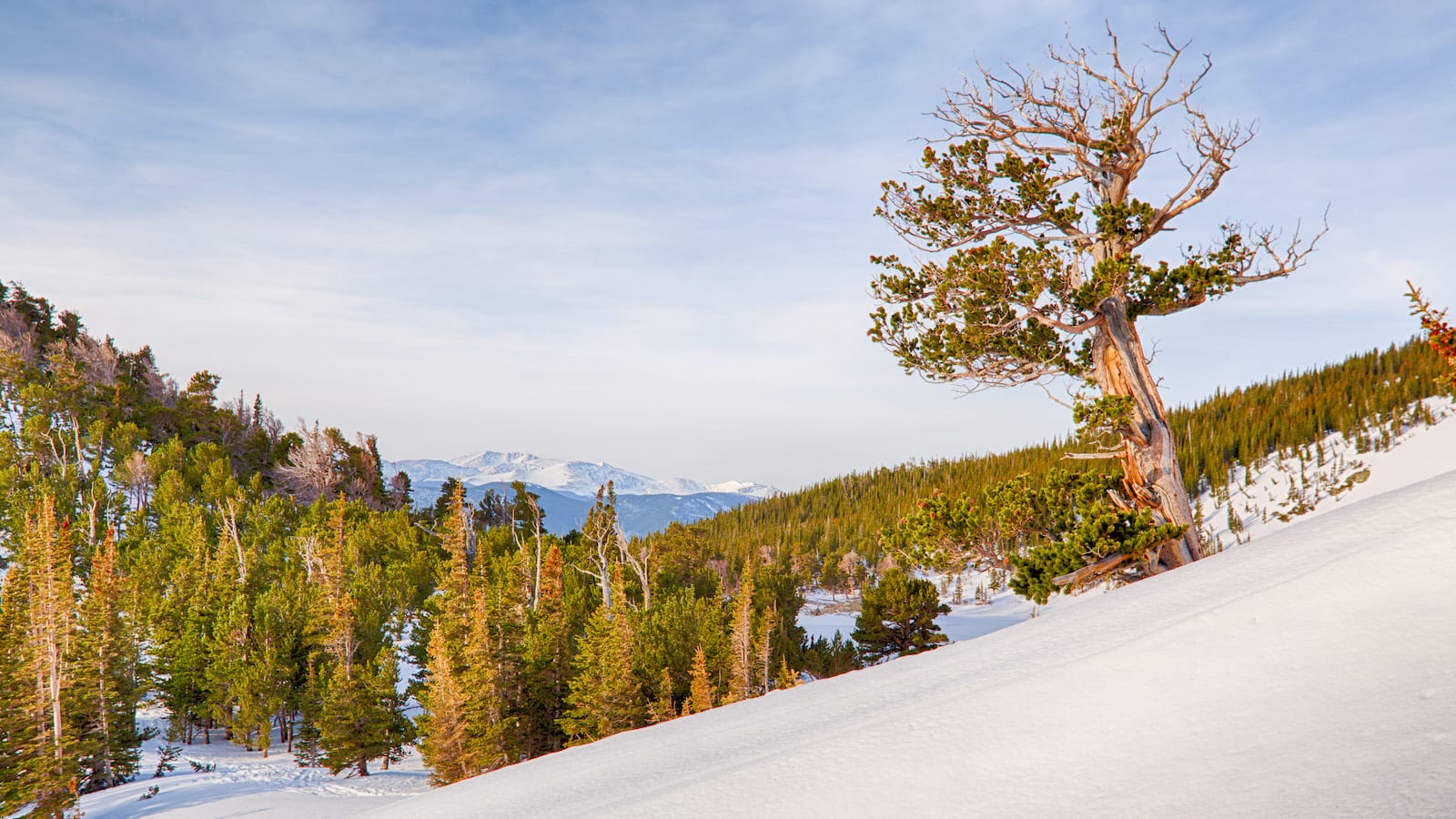
- Latin Scientific Name – Balfourianae
- Subspecies – Pinus aristata: Rocky Mountain bristlecone, Colorado bristlecone
- Mature Size – Average Height of 10-50′
- Subspecies – Pinus longaeva: Great Basin bristlecone pine, intermountain bristlecone pine, or western bristlecone pine
- Subspecies – Pinus balfouriana: Foxtail Pine
There are three species of bristlecone pines, all closely related to each other: Rocky Mountain bristlecone, great basin bristlecone, and foxtail pine. Only one of them is found in Colorado, the Rocky Mountain bristlecone, Pinus aristata. While these three species can hybridize in cultivation, none of their population ranges overlap in the wild.
The medium-sized Rocky Mountain bristlecone has a gray-brown bark, deep green/blue-green needles on the outface with white stomata on the inner, grouped in fascicles of five, and 1.5-2.5″ mature cones. Unique to this subspecies are small white resin flecks found on the needles, due to the resin canal being commonly broken. It’s reminiscent of dandruff, and no other pine shows it. Although not as long-living as the Pinus longaeva variety, it still grows old, on average up to 1,500 years. However, a Rocky Mountain bristlecone was estimated to be 2,480 years old at Black Mountain near Craig, CO.
The Rocky Mountain bristlecone is found throughout Colorado and northern New Mexico’s Rocky Mountains, as well as in Arizona’s San Francisco Peaks and Kaibab National Forest, north of the Grand Canyon. The elevations it inhabits are high, between 7,000 and 13,000 feet, so it likes the cold, dry weather. The further south, the higher the tree line. Colorado’s tree line typically ends between 11,000 and 12,000 feet. Pinus arista is the favorite for cultivation. It’s slow-growing, smaller, and suitable for cold climates.
One of the longest-living non-clonal organisms on Earth is the Pinus longaeva species, aka the Great Basin bristlecone. Some are 5,000 years old. It’s found only at a narrow latitude in Nevada, Utah, and California, but interestingly, not Colorado. The local Rocky Mountain bristlecone’s range does not overlap with the Great Basin type at all and is 160 miles apart at their closest point between Utah and Colorado. This gap is created by the Colorado and Green rivers.
Pinus balfouriana, aka Foxtail pine, is found in California and Oregon’s Klamath Mountains, as well as the Sierra Nevada mountain range in the Western U.S. The northern Owens Valley in eastern California provides a 20-mile gap between the Foxtail pine and Great Basin bristlecone pine.
Douglas-Fir
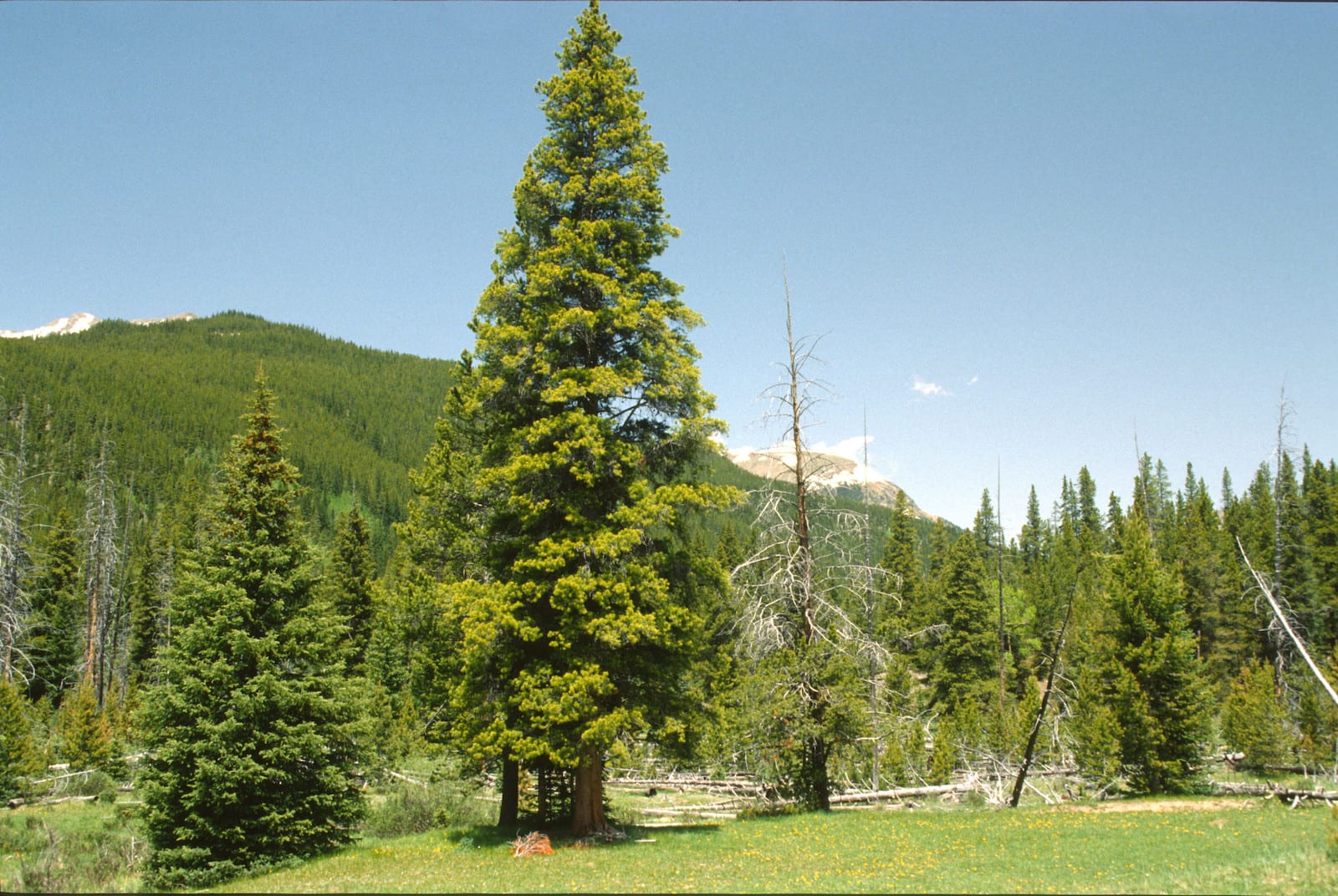
- Latin Scientific Name – Pseudotsuga menziesii
- Nicknames – Douglas-fir, Douglasfir
- Variety – Pseudotsuga menziesii var. glauca: Rocky Mountain Douglasfir, interior Douglasfir
- Mature Size – Average Height of 50-130′
- Variety – Pseudotsuga menziesii var. menziesii: Coast Douglasfir, Oregon pine, Columbian pine
Named after Botanist-explorer David Douglas, who discovered the tree in 1826, the Douglas-fir is a tree adored by the community. Interestingly, it’s either written as Douglas-fir with a hyphen, or Douglas-fir, as one word, because it’s not a true fir tree. It accounts for roughly half of all U.S. Christmas trees. It’s also used heavily in the lumber industry, the top lumber-producing tree, and for landscaping, in good part due to its rate of growth. David Douglas proclaimed it
one of the most striking and truly graceful objects in nature.
The medium to large-sized tree grows in a pyramid shape at a pace of about one to two feet per year in height. It prefers plenty of sunshine, space, and atmospheric moisture. It has downward-facing light brown cones, which grow to 3-4″ with a unique 3-pointed bract growing from between its scales. They hang down with consistent scales, unlike true firs.
The Douglas-fir greatly aided the expansion of the American West. It was used to make railroad ties and telephone/graph poles. It’s been used throughout history, including heavily in World War II. The U.S. Navy still uses minesweepers, the only wood ship they use, made of Douglas-fir. There are two varieties of Douglas-fir: Coast Douglasfir – var. menziesii, and Rocky Mountain Douglasfir – var. glauca.
Coast Douglas-fir is found along the western coast from British Columbia, south to California and western Nevada. It’s the longer-lived, faster, and taller of the two species. It has recorded heights of over 300′. Its needles are most often dark yellow-green, although sometimes blue-green. Mexican Douglas-fir, P. lindleyana, which goes as far south as Oaxaca, is frequently called a variety of P. menziesii.
The inland variety is the Rocky Mountain Douglas-fir, growing slower, shorter-live,d and rarely reaching heights over 130′. Its needles are usually the blue-green variety. The cones are a tad shorter, usually not more than 3″. The pine leaves from either Douglas-fir species can be used to make pine needle tea.
Engelmann Spruce
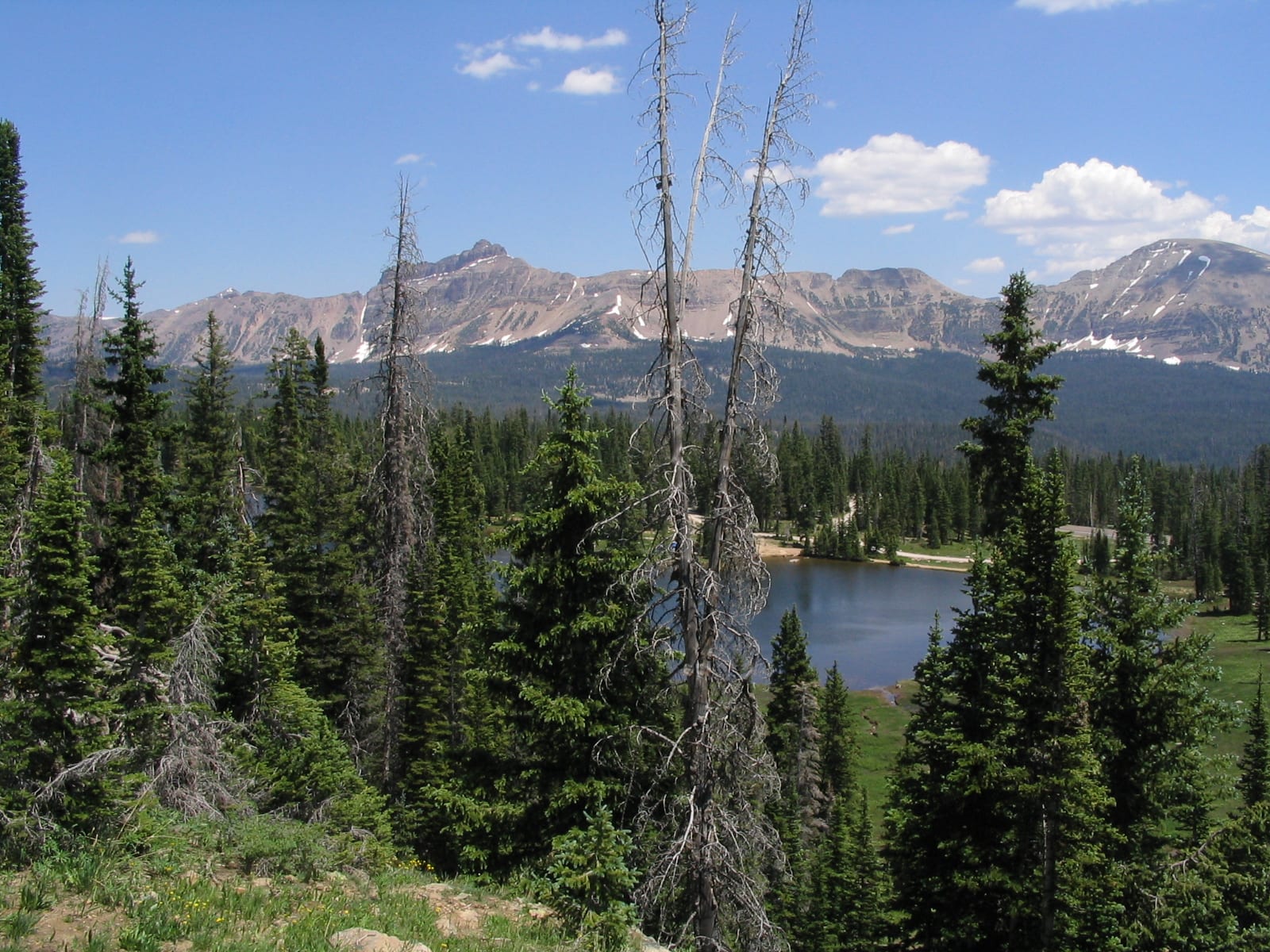
- Latin Scientific Name – Picea engelmannii
- Nicknames – Engelmann spruce, white spruce, mountain spruce, silver spruce
- Mature Size – Average Height of 45-130′
Native to the western side of North America, the Engelmann spruce is found from British Columbia and Alberta, south to Arizona and New Mexico. There are a couple of isolated populations in northern Mexico, sometimes treated as a distinct species and sometimes a subspecies. the Mexican Spruce – Picea engelmannii subsp. mexicana.
Englemann spruce is found in Colorado’s Rockies, growing at high elevations, up to 12,000 feet near the alpine tree line. It’s on the larger size, usually growing to around 100 feet, though it has been found in places to be over 200 feet tall. Young trees have cone-shaped crowns, while older ones are more like cylinders. The needles are blue-green with a few lines of stomata. The cylindric cones hang down loosely and grow 1.5-3″. They go from a reddish, dark purple color to brown at maturity.
Limber Pine
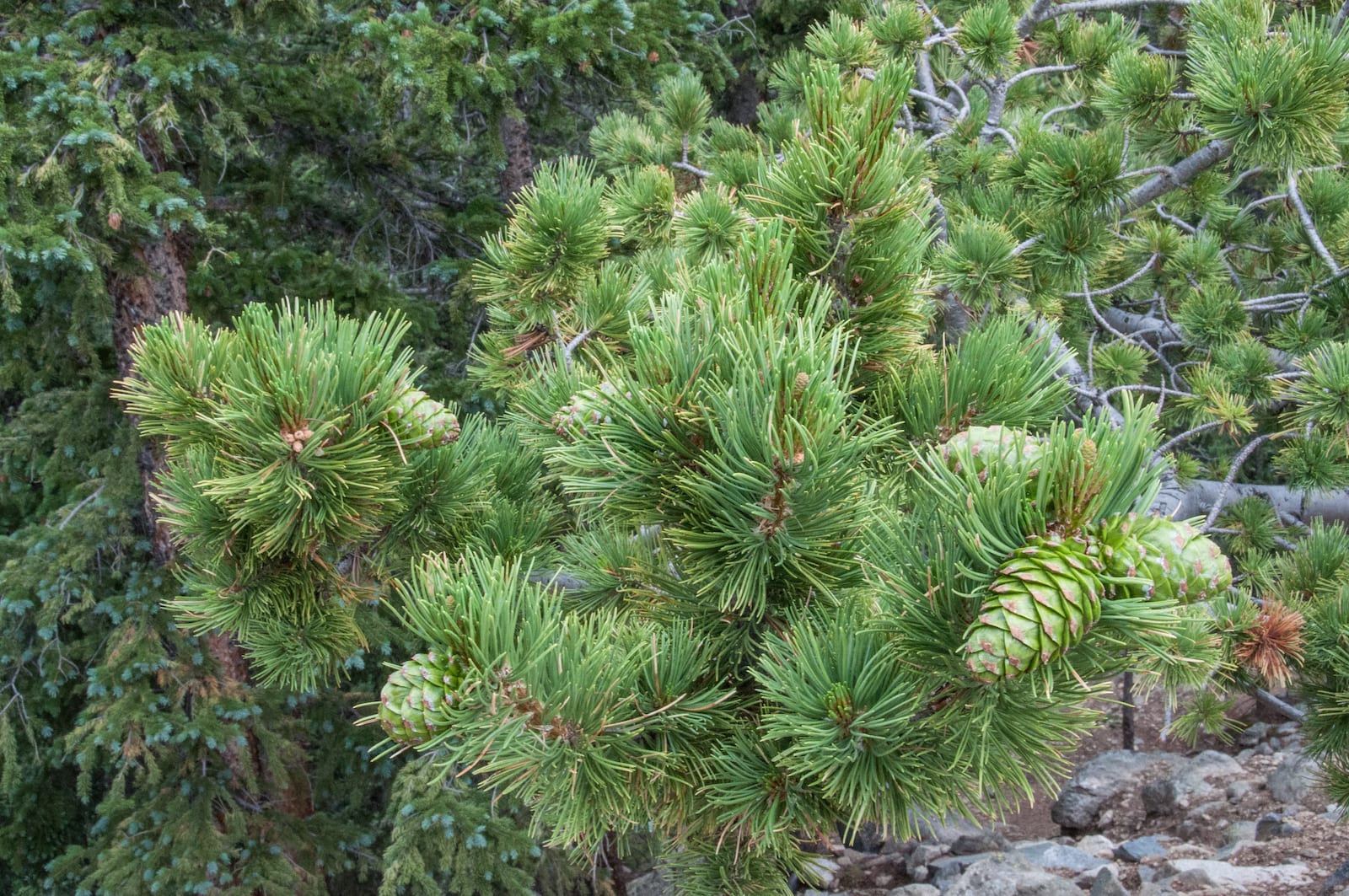
- Latin Scientific Name – Pinus flexilis
- Nicknames – Limber pine, Rocky Mountain white pine
- Mature Size – Average Height of 25-60′
Limber pine is one of the easier evergreen trees to identify, thanks to its unique, flexible “limber” branches. It’s found throughout the western United States, as well as Canada and Mexico. It’s most prevalent in the Rocky Mountains at high elevations just below the tree line. The limber pine is a long-living tree, with some of the oldest specimens found to be more than 2000 years old.
Its needles are green, sometimes blueish-green, and smooth, non-serrated. Since it’s part of the white pine group, all of its needles are in bundles of five. It has a dark gray, creased bark. The cones are 2-5″ long and green when immature. They are also not fragile, so you can usually find the intact cones lying under the tree. This is different from the fragile cones of the white pine, which birds can pick apart to get its seeds.
The limber pine can reach heights of up to 80 feet, though it’s often much smaller, especially the higher ones at the tree line. These highest-elevation trees are usually less than 30 feet tall. The P. flexilis is popular for ornamental landscaping and makes a great tree for the yard.
Lodgepole Pine
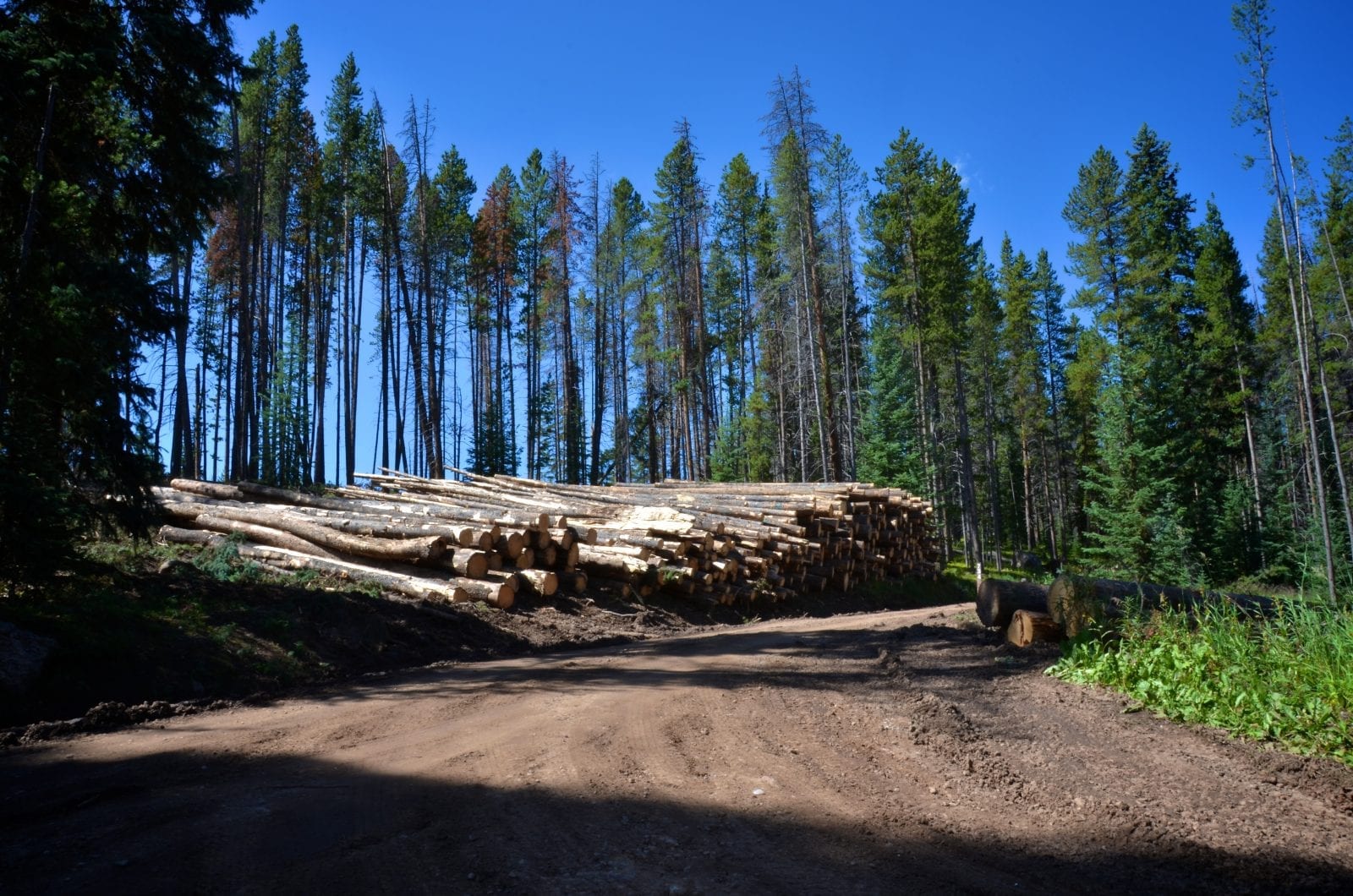
- Latin Scientific Name – Pinus contorta
- Nicknames – Lodgepole pine, twisted pine, contorta pine
- Subspecies – Pinus contorta subsp. latifolia: Lodgepole pine, black pine
- Mature Size – Average Height of 70-100′
- Subspecies – Pinus contorta subsp. murrayana: Tamarack pine, or Sierra lodgepole pine
- Subspecies – Pinus contorta subsp. contorta: Shore pine
- Subspecies – Pinus contorta subsp. bolanderi: Bolander’s beach pine, Bolander pine
There are four subspecies of Pinus contorta, listed above. The one native to Colorado is subsp. latifolia, lodgepole pine. Common throughout the western U.S., lodgepole pine is found near ocean shores in the northwest and dry, mountain regions like the Rockies. It’s also known as black pine.
It’s a good-looking tree with needles ranging from yellow-green to dark green, which are twisted in bundles of two. The trunk of the tree is long and thin, pole-like, with a short and narrow cone-shaped crown. Its bark is flaky, with colors ranging from orangish-brown to gray to black. It begins bearing 1.5″ cones, usually after six to ten years, which generally stay attached and closed for years.
The lodgepole pine is widely used commercially. It makes a great tree for the yard and is especially ornamental when young. It prefers at least four hours of sunshine, with some shade.
One-Seed Juniper
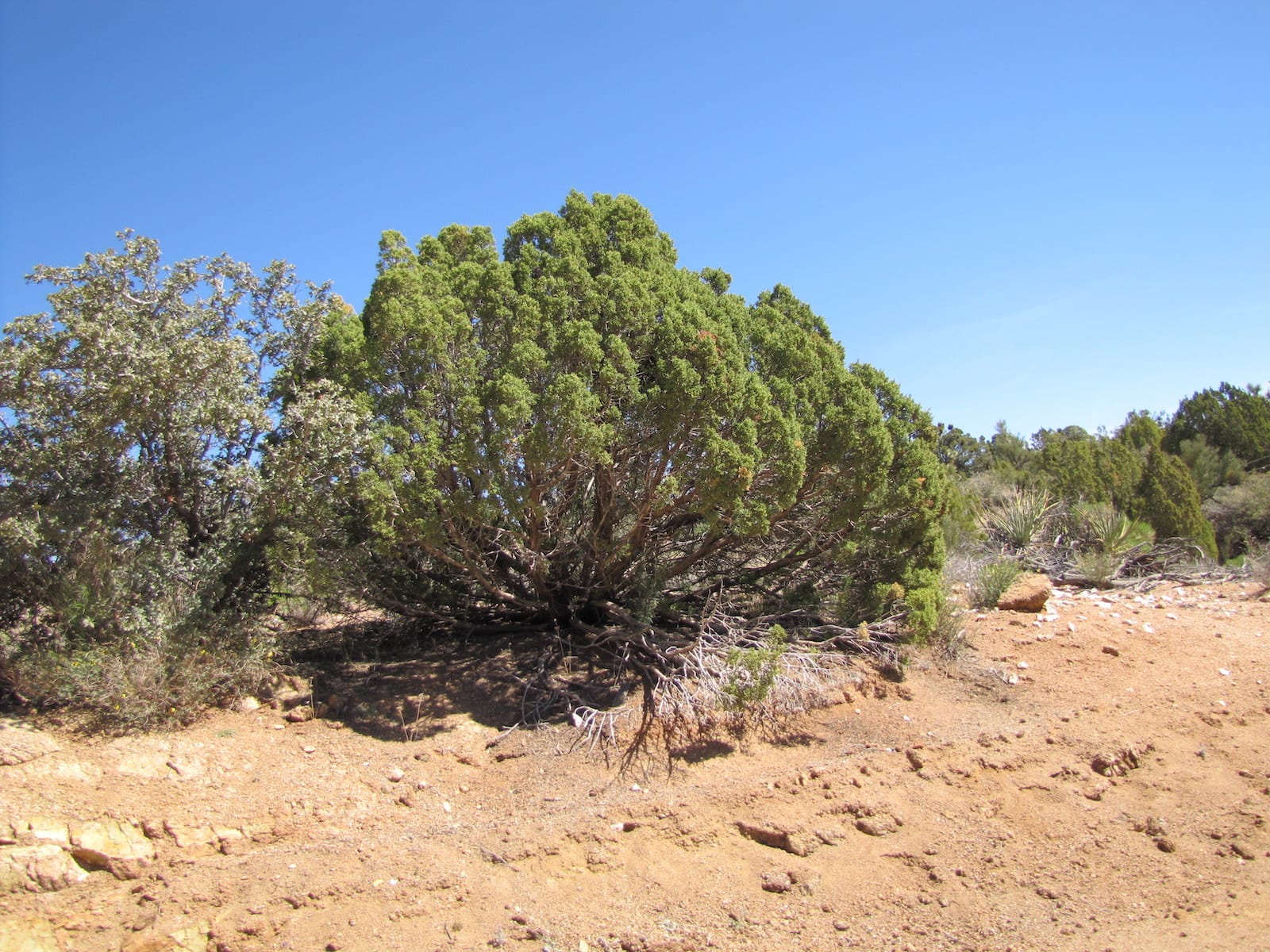
- Latin Scientific Name – Juniperus monosperma
- Nicknames – One-seed juniper
- Mature Size – Average Height of 6-25′
The one-seed juniper is found throughout the southwestern U.S., in Arizona, New Mexico, southern Colorado, the Oklahoma panhandle, and western Texas. It grows as both a shrub and a small tree, usually reaching 6 to 25 feet, 40 feet on the high end. Because it’s often a shrub, it’s multi-stemmed, with a thick, rounded crown.
The light to dark green leaves are scale-like and very small. They appear as needles on the younger plants. The bark is gray to brown. It produces berry-like cones, blue in color, containing a single seed, hence the name (though rarely a few seeds). The cones mature after 6-8 months. Birds and mammals will eat them. Its roots run deep, with the second deepest roots, after the shepherd tree found in South Africa.
The tree has a variety of uses, especially for the Native people. The Navajo eat the cones during fall and winter, as well as make a dye from them, along with the bark. Its wood is also used by the Natives, including the Zuni. Being resistant to rot, the wood is used for fences.
Pinyon Pine
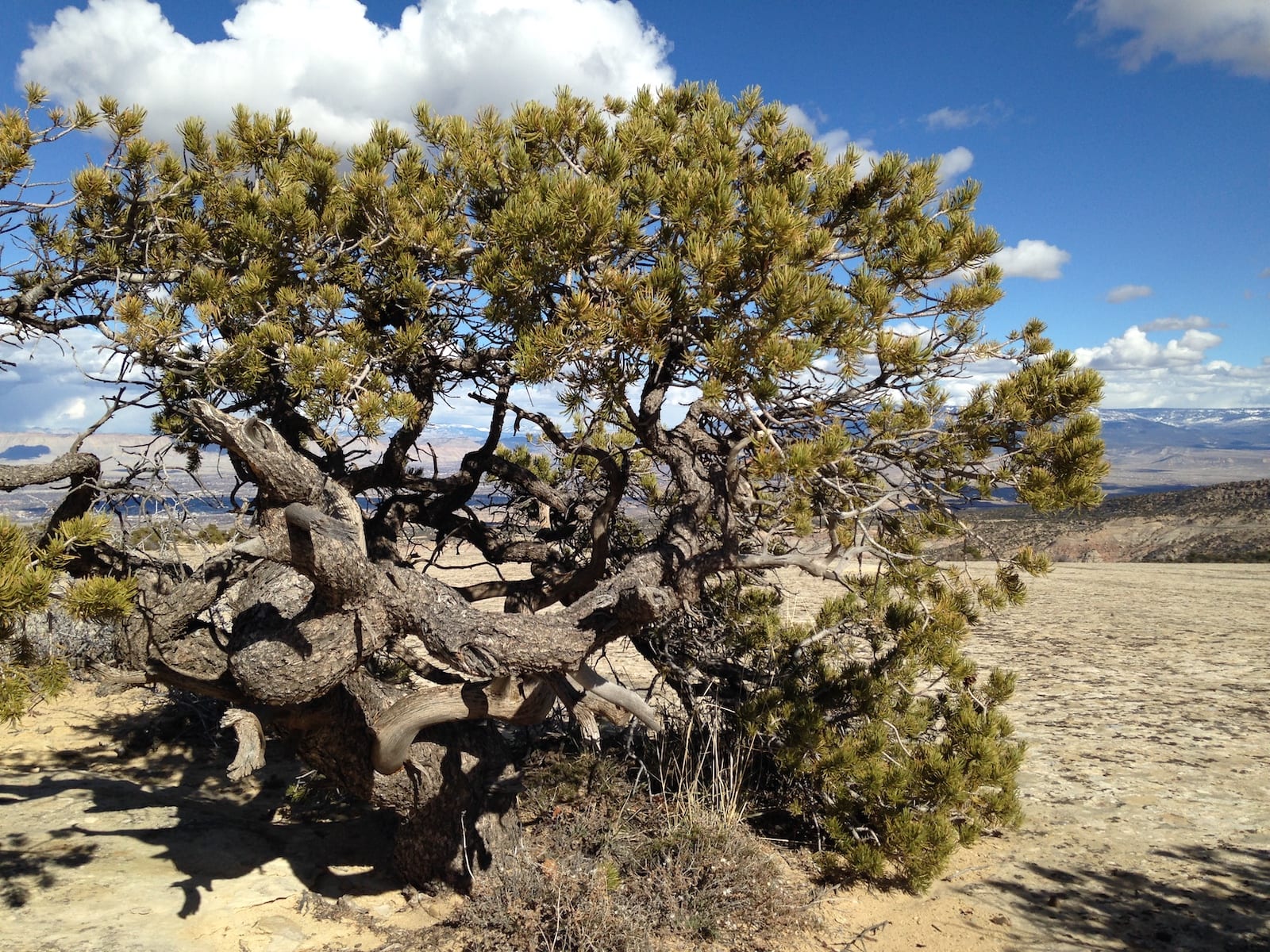
- Latin Scientific Name – Pinus monophylla
- Nicknames – Pinyon pine, piñon pine
- Species – Pinus edulis: two-needle piñon or Colorado pinyon
- Mature Size – Average Height of 33-66′
- Species – Pinus cembroides: Mexican pinyon
- Species – Pinus orizabensis: Orizaba pinyon
- Species – Pinus johannis: Johann’s pinyon (includes P. discolor – border pinyon)
- Species – Pinus culminicola: Potosi pinyon
- Species – Pinus remota: Texas pinyon or paper shell pinyon
- Species – Pinus monophylla: single-leaf pinyon
- Species – Pinus quadrifolia: Parry pinyon (includes P. juarezensis)
The pinyon pine grows in the dryer climates of the Southwest, including Arizona, New Mexico, Utah, and Colorado. There are eight true species of pinyon pine. Several can be found primarily in the southwestern reaches of Colorado, notably the two-needle piñon, aka Colorado pinyon – pinus edulis. P. edulis is also found in the southeast in Pinyon Canyon, Colorado.
It’s a small to medium-sized tree, generally growing around 30 to 60 feet tall. The bark is furrowed and scaly, with 1 to 2-inch green needles in sets of two. The cones are spherical and grow up to 2 inches. They start green and ripen to yellow in 18-20 months. When mature, they open and contain the seeds in the scales.
It produces edible nuts, which are a staple of Native American foods. It’s also a popular snack in New Mexican cuisine. The seeds are collected by the natives, who often hold the sole rights to harvest the seeds. The wood has a certain fragrance, making it a popular wood to burn in fires. The tree is known to have a positive effect on the surrounding soil in which it grows, adding nutrients to it.
Ponderosa Pine
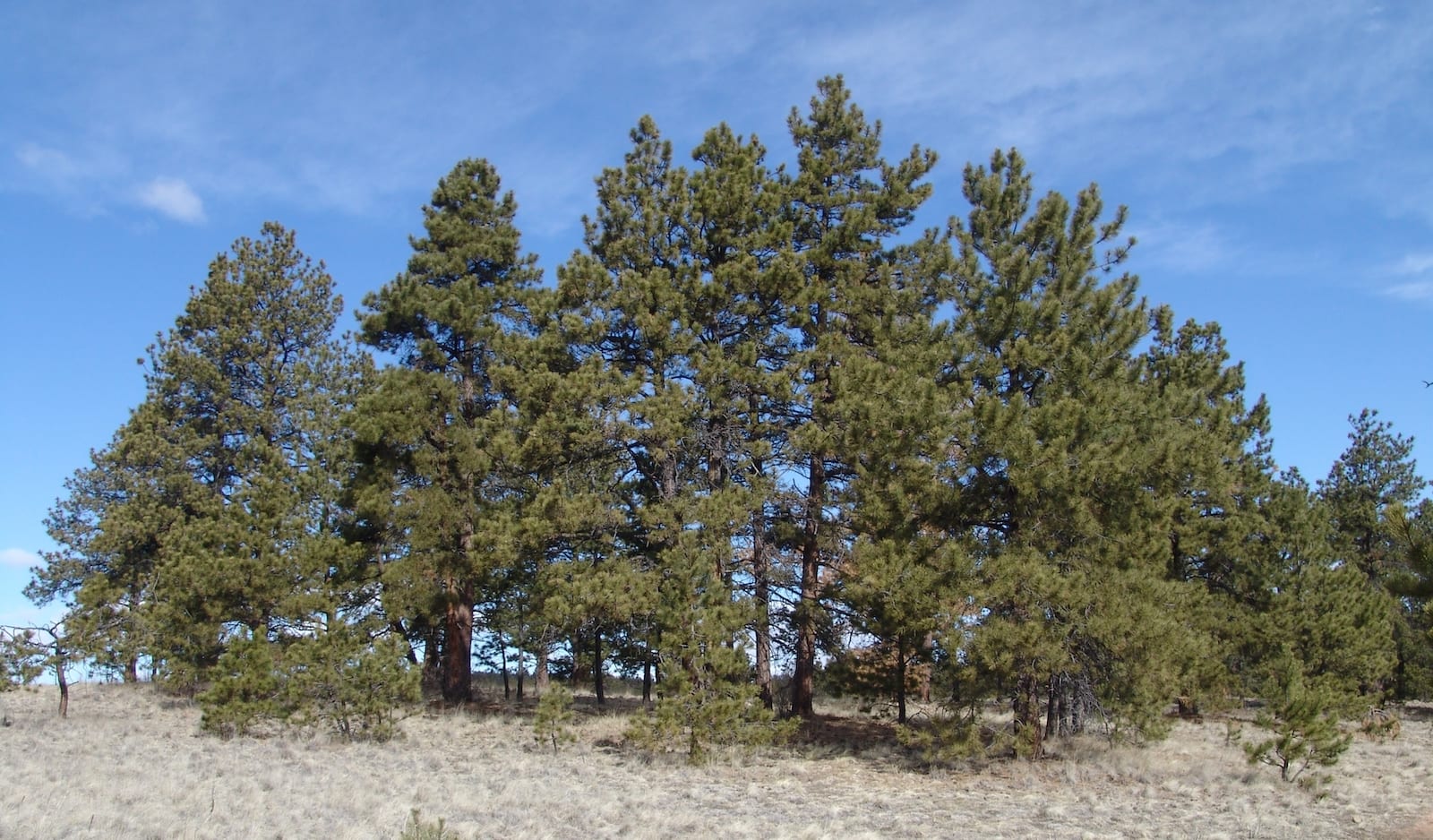
- Latin Scientific Name – Pinus ponderosa
- Nicknames – Ponderosa pine, bull pine, blackjack pine, western yellow-pine, filipinus pine, yellow pine, western longleaf pine, western red pine, western pitch pine, Sierra brown bark pine, and ponderosa white pine
- Mature Size – Average Height of 150′-230′
The ponderosa pine has the widest range of pines on the continent, found throughout the mountains of western North America. It’s a very tall, erect tree found growing in 16 western states. It grows first as a pyramid and then matures into a more cylindrical shape. It was first recorded by Scottish botanist David Douglas in 1826 but was misidentified. A few years later, he named it its species and called it ponderosa, for its heavy wood.
There are five subspecies of pine: Pacific, Columbia, Rocky Mountains, Southwestern, and High Plains. Their needles show the subtle differences between them. While the Pacific ponderosa pine needles are the longest and most flexible, the Rocky Mountains ponderosa pine have shorter, stout needles. The High Plains ponderosa pine has the fewest needles, the widest and stoutest.
The National Register of Big Trees has recorded a ponderosa pine that’s 235 feet tall. Most grow to around 150+ feet in the wild, with very deep root systems, protecting them from harsh winds. It produces reddish-brown cones, 3-6″ in length, each with a sharp prickle on the end. The bark of the ponderosa pine is quite distinct, with brown bark that has tones ranging from yellow to orange to red. Young trees have a darker, almost black bark, giving them the nickname “blackjacks”.
Rocky Mountain Juniper
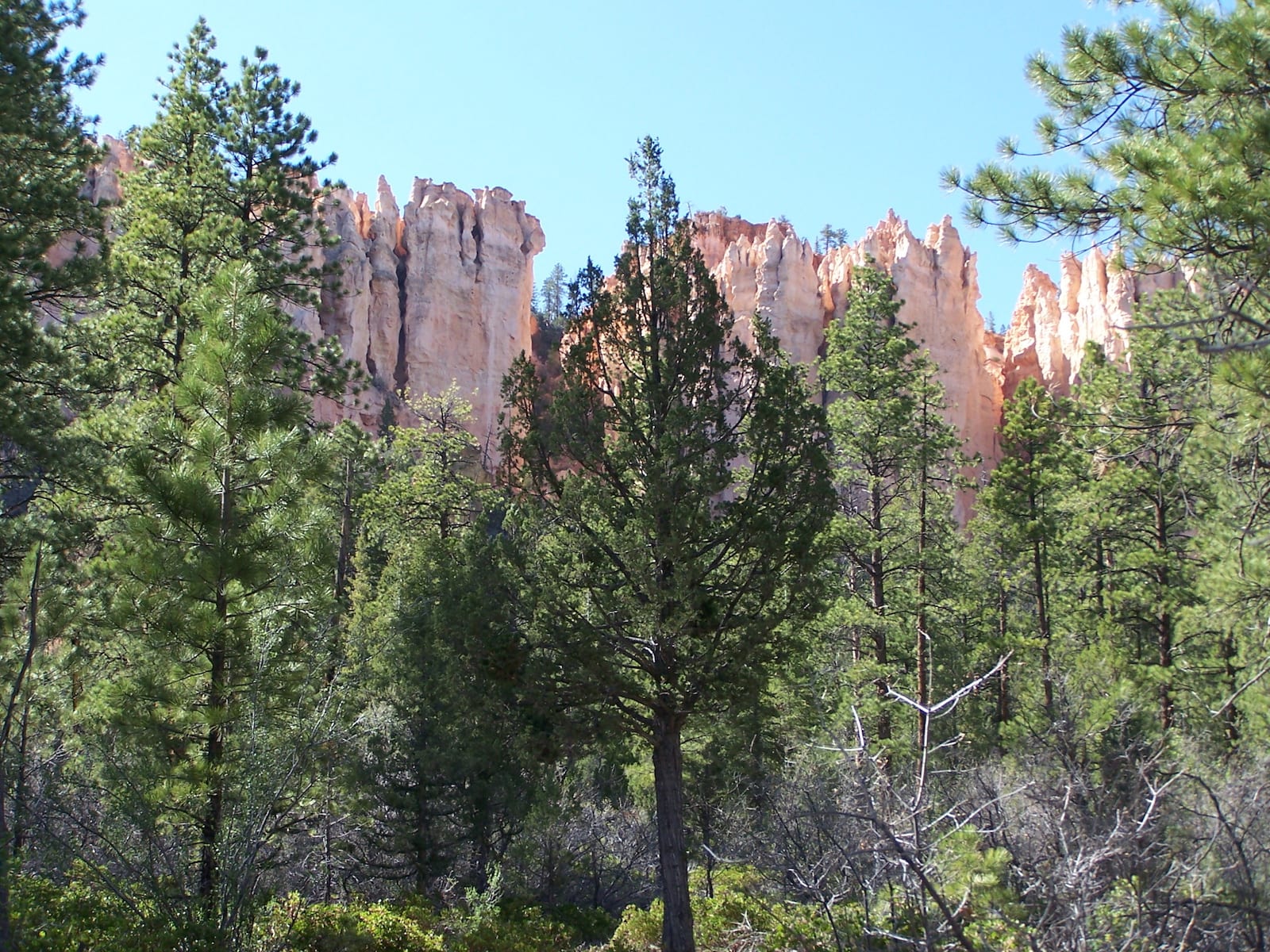
- Latin Scientific Name – Juniperus scopulorum
- Nicknames – Rocky Mountain juniper
- Mature Size – Average Height of 15-50′
The Rocky Mountain juniper grows throughout the North American West at elevations of 1,600 to 8,900 feet. In Colorado, you’ll find it mostly in the western side of the state and not in the highest parts of the Rockies. Its scientific name, scopulorum, translates to “of the mountains” in Latin.
It’s a small growing tree, usually around 2o to 30 feet, rarely reaching as high as 65 feet. It produces berry-like seed cones, which contain two seeds (occasionally one or three). After 1.5 years, they mature, and wildlife consumes them. It also has pollen cones, which are either entirely female or male, depending on the tree. It has green leaves and no needles.
The tree lives a long time, with some of the oldest specimens found to be 1,500-2000 years old. The Native Americans make use of the tree, infusing its leaves and bark to treat colds. It’s also a popular plant used for bonsai.
Southwestern White Pine
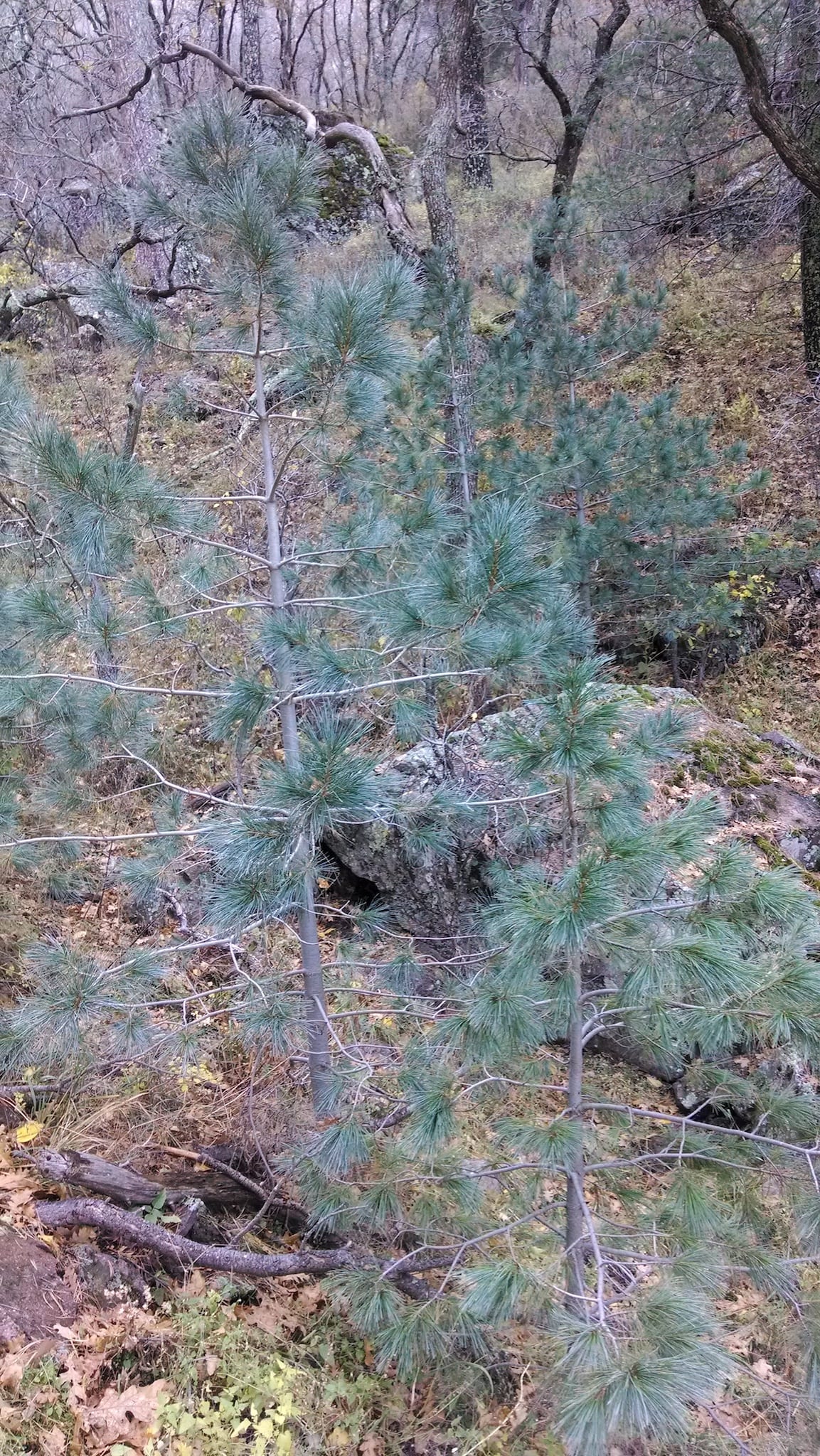
- Latin Scientific Name – Pinus strobiformis
- Nicknames – Southwestern white pine, Mexican white pine, or Chihuahua white pine
- Mature Size – Average Height of 50-100′
As its name implies, the Southwestern White Pine is native to the Southwest. It’s found in Southwest Colorado, as well as Arizona, New Mexico, and western Texas. It generally grows at high elevations, much like other evergreens on this list, and can reach 100 feet in height. It’s also usually found growing amongst other conifers versus by itself, surrounded by species such as limber pine.
Immature trees have smooth, light gray bark, which matures to a furrowed, reddish-brown, or dark grayish-brown. The leaves are dark green to blue-green needles in bundles of five (sometimes four). The cones are quite big, 6-20″ in length, producing large seeds. The southwestern white pine does very well with little water, although it can grow successfully in moist areas.
Subalpine Fir: Corkbark Fir and Rocky Mountain Fir
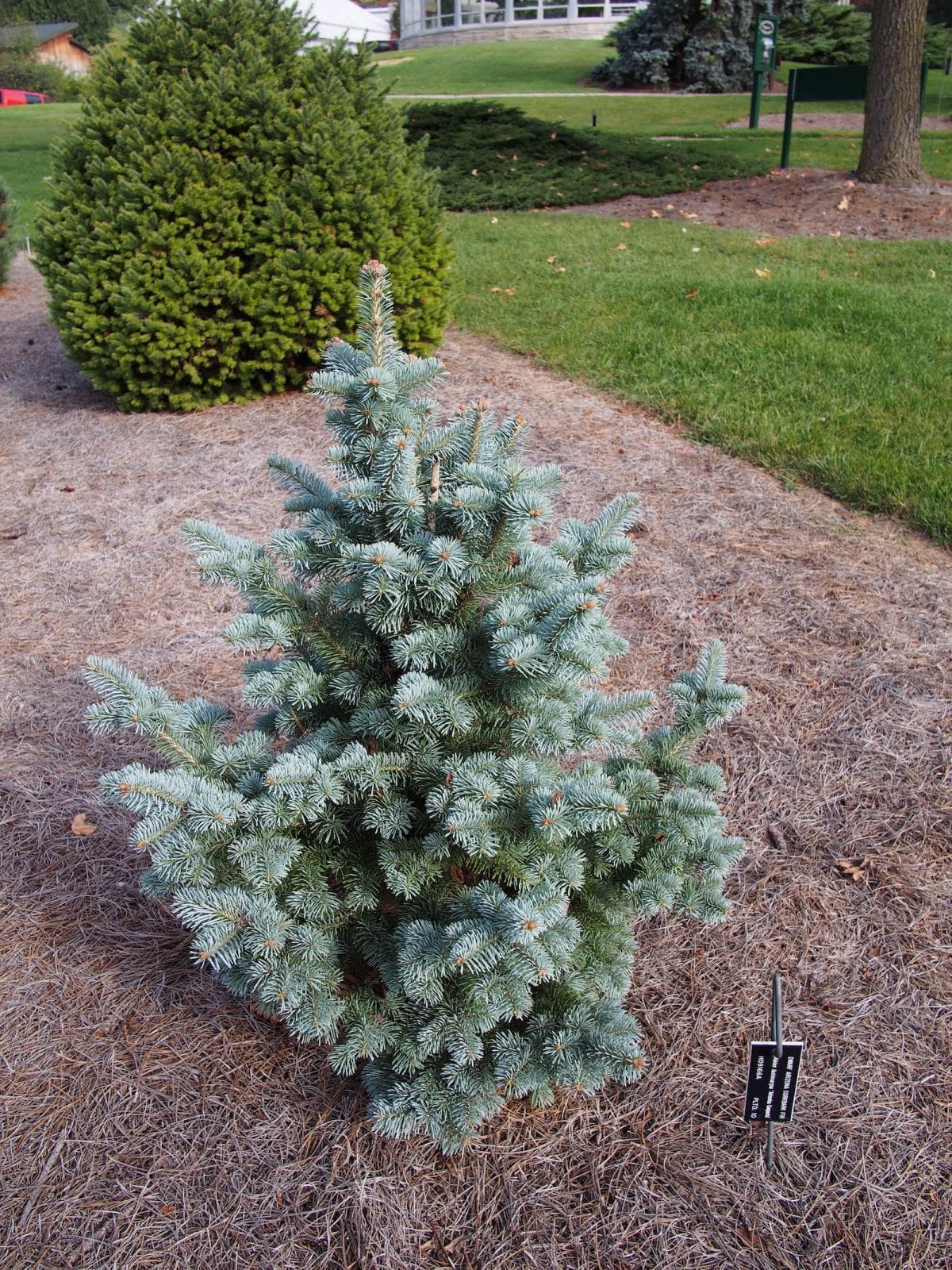
- Latin Scientific Name – Abies lasiocarpa; var. bifolia in CO and var. arizonica
- Nicknames – Subalpine fir
- Variety – Abies lasiocarpa var. bifolia: Rocky Mountain subalpine Fir
- Mature Size – Average Height of 115–150′
- Variety – Abies lasiocarpa var. arizonica: Corkbark Fir
- Mature Size – Average Height of 30-60′
- Variety – Abies lasiocarpa: Coast Range subalpine fir
Subalpine fir are found throughout western North America at elevations of between 8,000 and 11,000 feet. They typically grow to around 20 meters but have been found as high as 40 to 50 meters. There are either two or three taxa of subalpine fir, depending on who’s classifying them: Coast Range subalpine fir – Abies lasiocarpa; Rocky Mountain subalpine fir – Abies bifolia; and cork bark fir – Abies arizonica. The latter two are found in Colorado. All three are very similar.
The medium-sized subalpine fir tree most commonly found in Colorado is referred to as the Rocky Mountain fir. It’s classified in one of three ways: either as its species – Abies bifolia; as a variety of the Coast Range – Abies lasiocarpa var. bifolia; or not distinguished as all, falling under the same Abies lasiocarpa as the Coast Range. The Flora of North America says it is its own species, whereas the USDA includes it as Abies lasiocarpa without any variety.
You can find the Rocky Mountain Fir from the eastern Alaska Range south to Colorado. In contrast, the Coast Range subalpine fir inhabits the Pacific Coast Ranges, Olympic Mountains, and Panhandle Mountains from southeast Alaska to California. The differences are subtle and include resin composition and the Rocky Mountain Fir having yellow-brown fresh leaf scars versus reddish ones. Both have a smooth gray bark with resin blisters that become rougher on old trees, even scaly. The needles are a green or blueish color (like the aforementioned blue spruce). The blackish-purple cones grow to 2-5″ and stand erect.
The Corkbark fir, as its scientific name implies (arizonica), is found mostly in Arizona and New Mexico. You can find it in southern Colorado, especially the area around Wolf Creek Pass, as well as south and west of the Arkansas River. The resin composition is more similar to the Rocky Mountain fir than the Coast Range fir. The Flora of North America classifies it as Abies bifolia without distinction, whereas the USDA says it is a variety of Abies lasiocarpa var. arizonica. It differs from the other two species in that it has a paler gray, almost white bark.
Utah Juniper
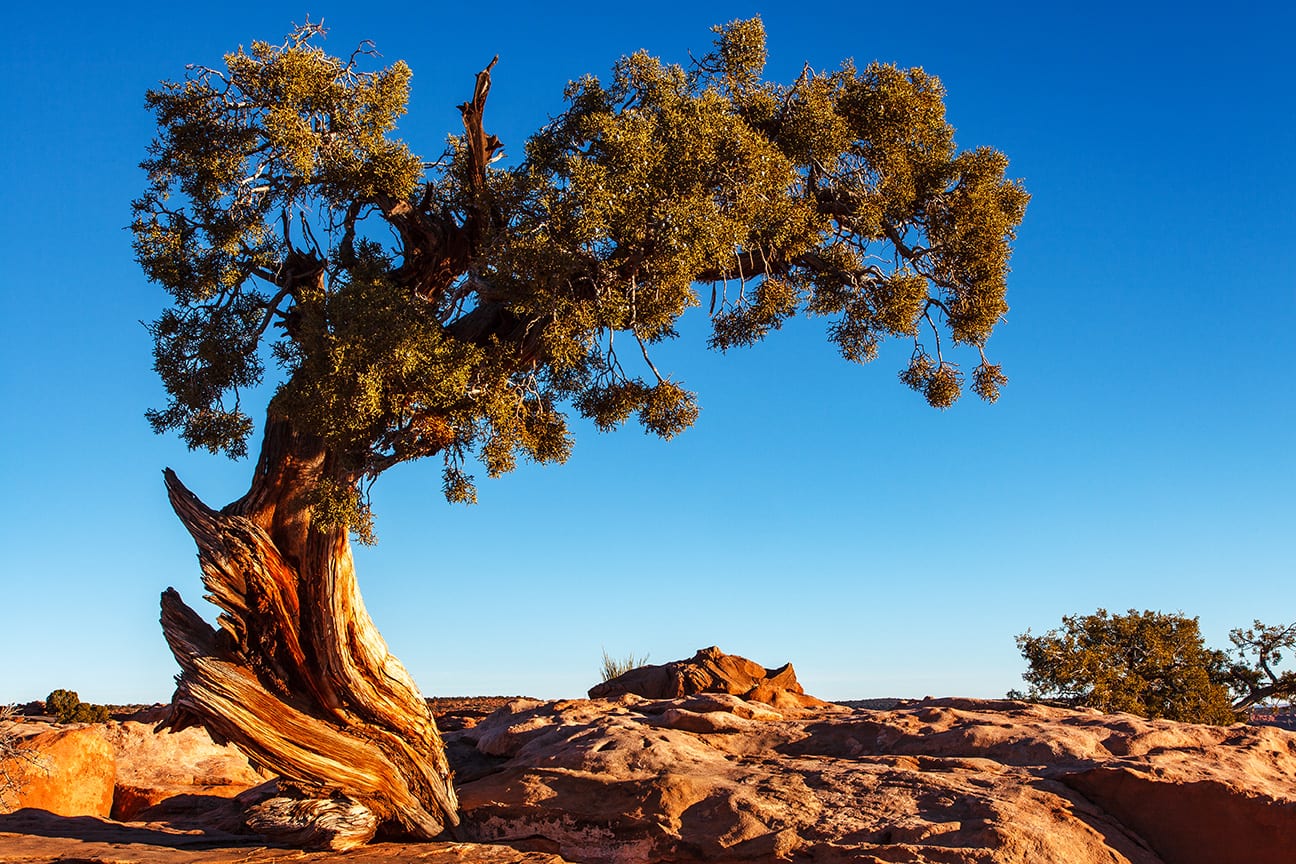
- Latin Scientific Name – Juniperus osteosperma
- Nicknames – Utah juniper
- Mature Size – Average Height of 10-20′
This is a smaller tree-like shrub, native to the Southwest, found mainly in Arizona, New Mexico, Utah, and western Colorado, as well as some parts of eastern California, Wyoming, southern Montana, and Idaho. The Utah juniper grows to a height of 20 feet on average, rarely ever reaching 30 feet in height. It grows at elevations of 4,300 to 8,500 feet.
Lacking needles when mature, its adult leaves are green and scaly, although as a youth, the leaves are needle-like. It makes berry-like cones that produce a single seed (rarely two). After a year and a half, they mature and are eaten by wildlife. Cones of both sexes are found on a single plant, roughly 90%, the other 10% will have either cones of solely male or female gender. The tree has a variety of uses by the Natives.
White Fir
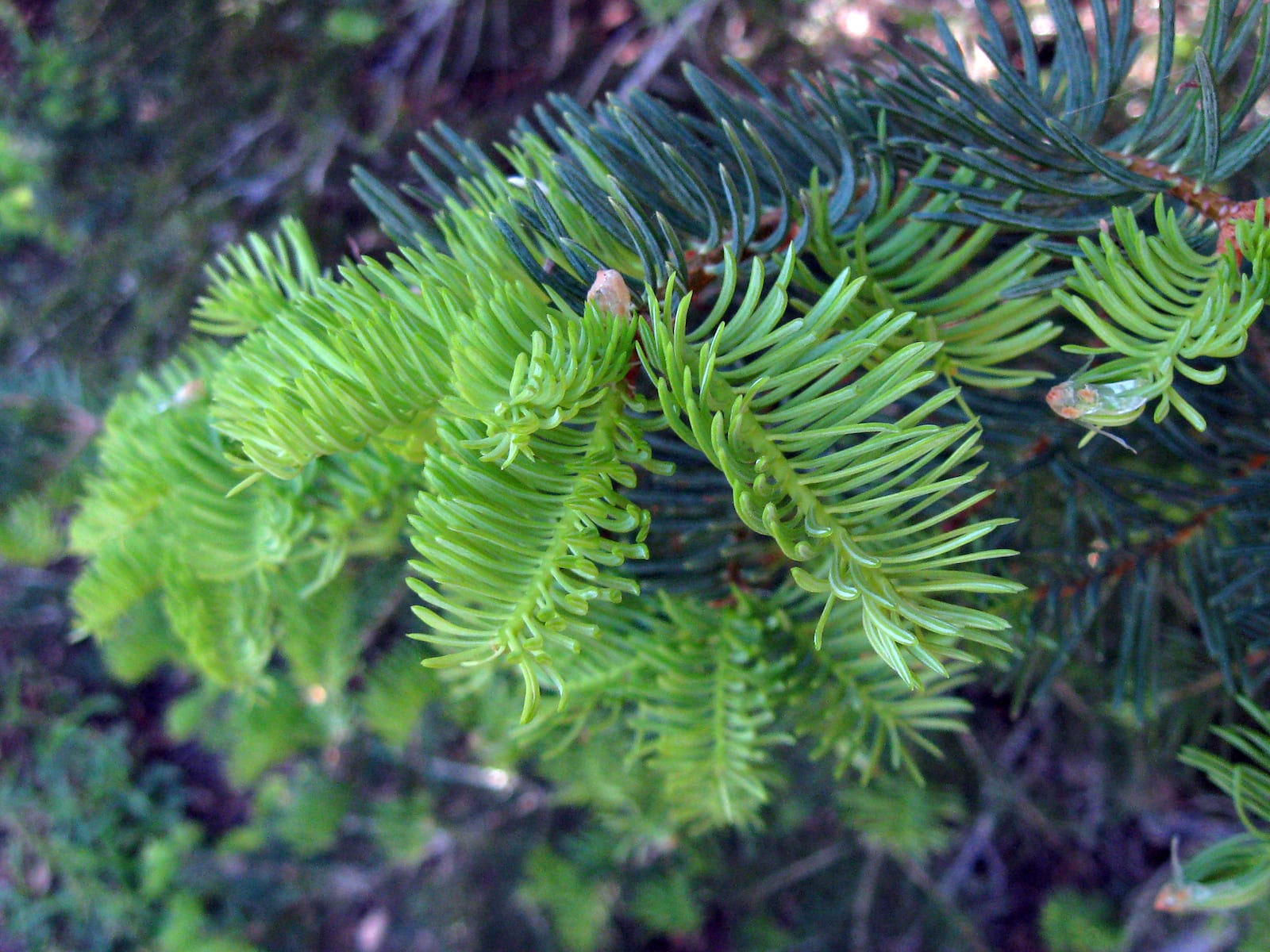
- Latin Scientific Name – Abies concolor
- Nicknames – White fir
- Subspecies – Abies concolor subsp. concolor: Colorado white fir or Rocky Mountain white fir
- Mature Size – Average Height of 80-110′
- Subspecies – Abies concolor subsp. lowiana: Low’s white fir or Sierra Nevada white fir
- Mature Size – Average Height of 130-195′
Found throughout the western part of North America, the white fir is a tall evergreen tree. There are two subspecies, which are sometimes treated as varieties by authors: subsp. concolor and subsp. lowiana. The former subspecies is known as the Colorado white fir or Rocky Mountain white fir. It can be found growing throughout the southern Rockies of Utah and Colorado, among other places. It lives at elevations of 5,600 feet up to 11,200 feet.
Subspeciies lowiana is the bigger of the two. Its tallest growing specimens are found in the central Sierra Nevada of California, while the Rocky Mountain white fir typically grows no more than 13 feet in height. Its Latin scientific name, concolor, means “all one color”. The needles are green/blue-green and flattened. The oblong cones are about 3 to 6 inches long and ripen from a green-purple to pale brown. It makes winged seeds, which get dropped about 6 months after pollination when the cones fall apart.
The pyramidal tree is commonly used in landscaping because of its color, shape, and ability to contend with harsh conditions. It’s also popular during Christmastime. It’s seldom used in the lumber industry. In 1953, naturalist Donald Peattie predicted its future,
Rather does the future of this tree lie in its value as an ornamental?
That’s a roundup of the most common evergreen trees found in Colorado. See if you can get to know our native trees’ wildlife and spot them on your next hiking or camping trip. If you’re looking to plant a few of these, read over our gardening in Colorado article for relatable tips on planting at elevation.

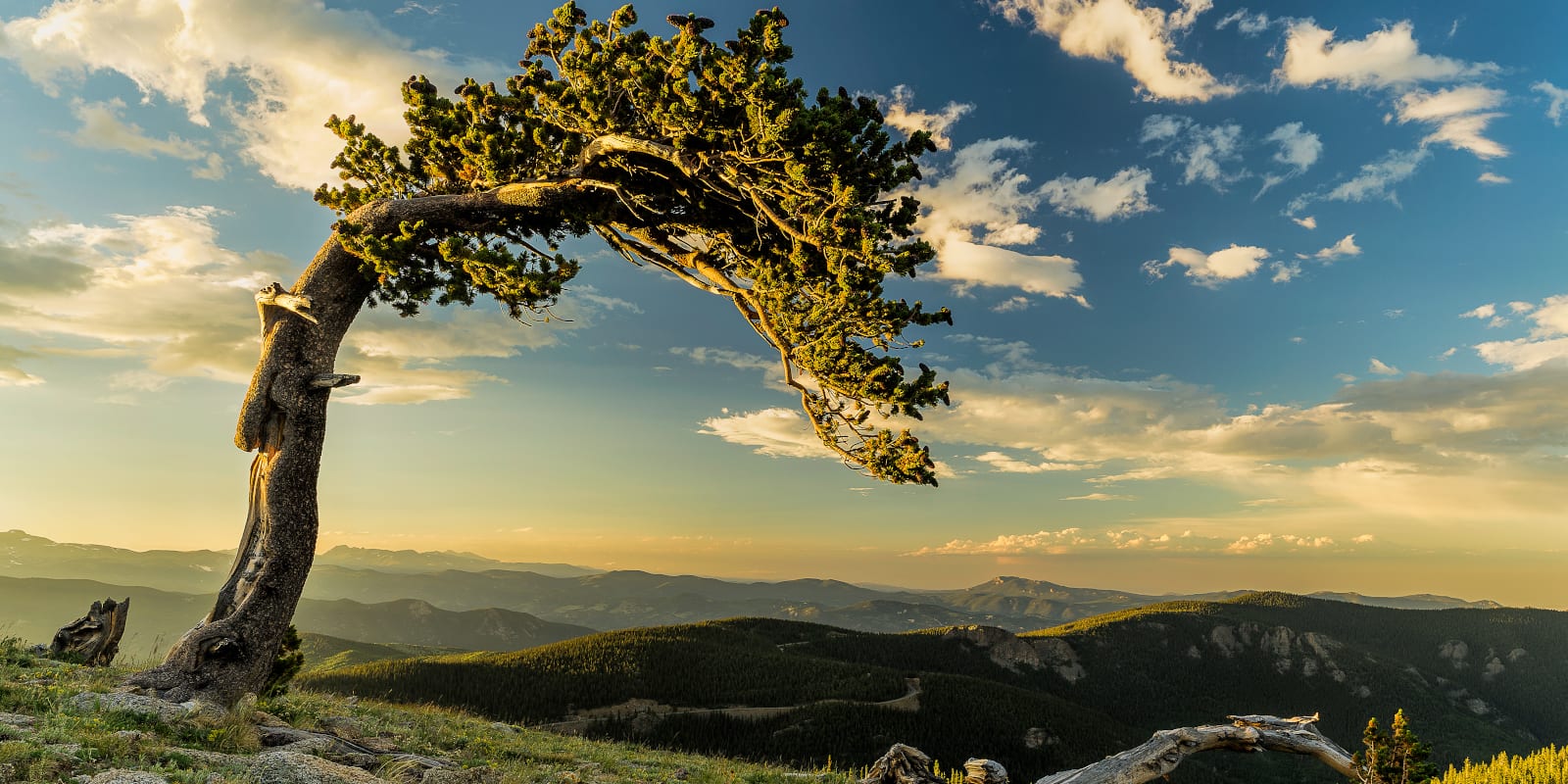
 Camp at these Colorado Casino RV Parks
Camp at these Colorado Casino RV Parks